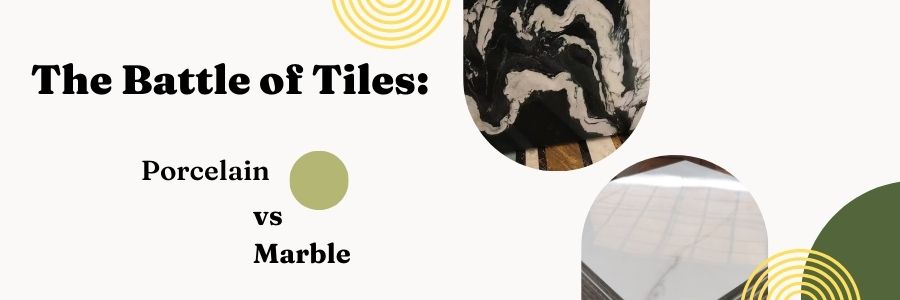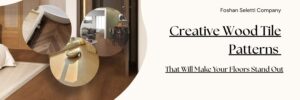As a ceramic and porcelain tile supplier in China, I’ve noticed a growing trend among importers and distributors: the increasing demand for premium natural-looking surfaces. Two materials consistently top the list: porcelain tiles (particularly those that mimic natural stone) and genuine marble.
Both options offer stunning aesthetics, but they differ dramatically in practical aspects that matter to your customers. This guide will help you understand the key differences so you can make informed importing decisions and better advise your clients.
What Are the Pros and Cons of Porcelain vs. Marble?
Here’s a straightforward breakdown of the advantages and disadvantages of each option to help you make informed importing decisions.

Porcelain Tile Pros:
- Superior durability: Highly resistant to scratching, chipping, and wear
- Virtually maintenance-free: No sealing required, ever
- Stain resistant: Non-porous surface repels all common staining agents
- Water resistance: 100% waterproof and suitable for any moisture-prone area
- Design versatility: Available in countless styles, including realistic marble looks
- Cost-effective: Lower initial cost and minimal lifetime maintenance expenses
- Heat resistance: Won’t scorch or discolor from hot items
- Freeze-thaw stable: Can be used in outdoor applications in any climate
- Consistent quality: Predictable performance across all pieces
- Large format options: Available in sizes up to 1600x3200mm for minimal seaming
- Lightweight options: Thin porcelain panels available for wall applications
Porcelain Tile Cons:
- Harder feel underfoot: Less giving than some natural materials
- Installation complexity: Requires skilled installation for best results
- Repair limitations: Difficult to repair if damaged (though damage is rare)
- Resale perception: Some luxury buyers still prefer natural stone
- Sound reflection: Can contribute to noisier spaces without acoustic treatment

Marble Pros:
- Unique natural beauty: Each piece has one-of-a-kind patterns and veining
- Prestigious reputation: Long history as a luxury material
- Natural material: Appeals to those seeking non-manufactured products
- Potential property value: May increase resale value in ultra-luxury markets
- Patina development: Develops character and unique aging over time
- Translucent quality: Some white marbles have a luminous, glowing quality
Marble Cons:
- High maintenance: Requires regular sealing and careful cleaning
- Extremely susceptible to staining: Acidic substances cause permanent etching
- Scratching vulnerability: Relatively soft surface scratches easily
- High cost: Significantly more expensive than porcelain alternatives
- Inconsistent quality: Natural faults and variations affect performance
- Heavy weight: More difficult to transport and install
- Limited applications: Not suitable for many high-traffic or wet areas
- Porosity concerns: Absorbs water and can develop stains and discoloration
- Climate sensitivity: Not recommended for outdoor use in freeze-thaw climates
- Size limitations: Restricted by natural slab sizes
- Professional maintenance: Often requires periodic professional restoration
Which Material Wins in Key Categories?
| Category | Winner | Explanation |
| Initial Cost | Porcelain | Significantly less expensive than comparable marble |
| Lifetime Cost | Porcelain | No maintenance costs and longer lifespan |
| Durability | Porcelain | Significantly harder and more resistant to damage |
| Maintenance | Porcelain | No sealing or special cleaning products required |
| Stain Resistance | Porcelain | Non-porous surface prevents staining |
| Design Variety | Porcelain | Unlimited designs, colors, and patterns available |
| Natural Beauty | Marble | Each piece has unique, natural character |
| Luxury Perception | Marble | Both materials are recognized as premium options, but marble is more luxury with nature |
| Commercial Use | Porcelain | Better performance in high-traffic environments |
| Wet Areas | Porcelain | Superior water resistance and slip resistance |
| Outdoor Use | Porcelain | Frost-resistant and fade-resistant |
What Are the Key Differences in Material Composition?
Understanding how these materials are made explains many of their performance differences:
| Aspect | Porcelain Tile | Marble |
|---|---|---|
| Composition | Refined clay, feldspar, silica fired at high temperatures | Natural metamorphic rock formed from limestone |
| Formation Process | Manufactured in controlled factory conditions | Formed naturally over millions of years |
| Structure | Dense, uniform, engineered material | Natural variations, veining, and potential hidden faults |
| Water Absorption | <0.5% (virtually non-porous) | 2-5% (naturally porous) |
The controlled manufacturing process of porcelain gives us the ability to create consistent products with predictable performance, while marble’s natural formation creates unique pieces but also introduces variables in quality and durability.
How Do Initial and Lifetime Costs Compare?
The true cost difference extends far beyond the purchase price:
What’s the Price Difference at Purchase?
Porcelain tiles (even high-quality marble-look options) are generally much more affordable than natural marble. Entry-level porcelain costs significantly less than the most basic marble, while even premium porcelain typically costs less than mid-range marble options.
Our partner manufacturer’s advanced technology allows us to produce porcelain tiles with remarkably realistic marble appearances at a fraction of the cost of genuine marble.
What Hidden Costs Should Importers Consider?
Additional Marble Costs:
- Higher shipping costs due to greater weight
- More breakage during transport (typically 5-10%)
- Requires additional sealing products
- Ongoing maintenance products and services
- Potential replacement of damaged tiles
Additional Porcelain Costs:
- Typically none beyond installation
For your distribution customers calculating total project costs, porcelain’s significant savings on maintenance and replacement often make it the more economical long-term choice despite sometimes having similar initial installation costs.

How Durable Is Each Material in Different Environments?
Durability directly impacts customer satisfaction and long-term reputation:
Daily Wear Resistance
- Porcelain Hardness: 7-8 on Mohs scale
- Marble Hardness: 3-4 on Mohs scale
This difference makes porcelain approximately twice as resistant to scratching and abrasion as natural marble.
Stain Resistance
- Porcelain: Non-porous surface resists all common stains
- Marble: Porous surface can be permanently stained by acidic substances (wine, lemon juice, tomato sauce), cosmetics, and oils
For commercial spaces like restaurants or high-traffic retail environments, porcelain’s superior stain resistance offers significant advantages worth highlighting to your customers.
Moisture Resistance
- Porcelain: Completely waterproof, suitable for indoor and outdoor use in any climate
- Marble: Absorbent and can develop water stains; not recommended for outdoor use in freeze-thaw climates
Our porcelain tiles undergo strict testing to ensure <0.5% water absorption, making them ideal for bathroom, kitchen, and outdoor applications where marble would be problematic.

What Installation Challenges Should Your Customers Know About?
Installation complexity affects project timelines and costs:
Installation Difficulty Comparison
Marble Installation Challenges:
- Extremely heavy (more labor required)
- Requires specialized wet cutting tools
- Needs perfect subfloor preparation
- Requires precision installation to align veining
- Must be sealed immediately after installation
Porcelain Installation Advantages:
- Lighter weight (though still substantial)
- Can be cut with standard tile cutting equipment
- More forgiving of minor subfloor imperfections
- No sealing required
- Consistent sizing for easier installation
For your distribution customers managing large projects, porcelain’s more straightforward installation process can reduce labor costs and project timelines by 15-30%.
What About Specialized Applications?
- Porcelain: Available in large formats up to 1200x2400mm, 1200x2600mm or 1200x2700mm, perfect for seamless wall applications
- Marble: Limited by natural slab sizes and weight, typically requiring more seams
Our partner manufactory specializes in large-format porcelain slabs that can be used for countertops, shower walls, and feature walls with minimal seaming—a significant advantage over natural marble.

What Maintenance Requirements Will Your Customers Face?
Ongoing maintenance dramatically affects end-user satisfaction:
Marble Maintenance Requirements:
- Requires sealing every 6-12 months
- Needs pH-neutral cleaners only
- Must be dried after contact with water to prevent spotting
- Polished surfaces require periodic professional restoration
- Scratches and etching require professional repair
Porcelain Maintenance Requirements:
- No sealing ever required
- Compatible with virtually any cleaning product
- Resistant to water spotting
- Maintains appearance without professional intervention
- Extremely difficult to scratch or damage
For commercial property managers and homeowners alike, the minimal maintenance requirements of porcelain translate to significant cost savings and convenience—a strong selling point for your distribution business.
Environmental impact has become increasingly important to end consumers:
What’s the Environmental Footprint?
- Porcelain: Energy-intensive production but extremely long lifespan; completely recyclable
- Marble: Natural resource extraction; lower processing energy but requires global transportation; higher replacement rate
What Design Possibilities Does Each Material Offer?
Aesthetic versatility affects market appeal:
Visual Variety
- Marble: Limited to naturally occurring patterns and colors
- Porcelain: Unlimited design possibilities, including accurate reproductions of rare marbles
Our advanced digital printing technology allows us to recreate the appearance of extremely rare marble varieties that would be prohibitively expensive or even unavailable on the natural stone market.
Size Options
- Marble: Typically limited to slab sizes around 2000x1000mm with significant thickness
- Porcelain: Available in formats from small mosaics to large-format slabs up to 1600x3200mm with thinner profiles
The variety of size options in porcelain gives designers greater flexibility while reducing weight and installation complexity.
What Specific Applications Favor Each Material?

Different settings have different requirements:
Where Does Marble Excel?
- Ultra-luxury residential projects
- Historic restoration work
- Traditional high-end hotels and resorts
- Statement pieces and focal points
- Projects where natural variation is highly valued
Where Does Porcelain Perform Better?
- Commercial high-traffic areas
- Food service environments
- Healthcare facilities
- Outdoor applications
- Modern and contemporary designs
- Budget-conscious luxury projects
- Wet areas (bathrooms, spas, pools)
By stocking both options, you can serve diverse market segments while positioning porcelain as the practical premium choice for most applications.
How Do Import and Distribution Logistics Compare?
Practical considerations affect your bottom line:
Shipping and Handling Differences
- Marble Weight: 150-180 lbs per cubic foot
- Porcelain Weight: 100-130 lbs per cubic foot
This significant weight difference means you can import approximately 30-40% more square footage of porcelain compared to marble in the same shipping container.
Breakage Rate Concerns
- Marble Breakage Rates: Typically 5-10% during intercontinental shipping
- Porcelain Breakage Rates: Less than 1% with proper packaging
Our manufactory uses specialized high-density packaging that virtually eliminates breakage during transport, maximizing your profitability when importing from China.
What Marketing Strategies Work Best for Each Product?
Based on my experience with successful distributors:
How Should You Position Porcelain to Customers?
- Emphasize “practical luxury” messaging
- Focus on lifetime value and reduced maintenance
- Highlight technological advancements in design realism
- Showcase environmental benefits and sustainability
- Demonstrate superior performance in challenging environments
How Should You Position Marble to Customers?
- Focus on heritage, tradition, and timeless appeal
- Emphasize the uniqueness of each piece
- Highlight the natural origin and authenticity
- Position as the ultimate luxury statement
- Create exclusive, limited-availability offerings
Conclusion
Both porcelain and marble have important places in the premium surfacing market. As a Chinese porcelain supplier, I naturally highlight the practical advantages of high-quality porcelain, particularly for:
- Commercial and high-traffic applications
- Moisture-prone environments
- Projects with tight maintenance budgets
- Modern architectural styles
- Clients wanting consistent, predictable results
However, natural marble remains unmatched for:
- Ultra-luxury residential projects
- Clients seeking one-of-a-kind natural materials
- Historical renovations requiring authentic materials
The most successful importers I work with maintain a strategic mix of both products, using porcelain to serve the broader market while offering select marble options for premium projects where budget is less constrained.
Want to learn how other flooring options compare? Check out our other comparison guides:
- Tile vs Wood Flooring: Pros, Cons and Market Opportunity
- Tile vs Vinyl Flooring: Which Offers Better ROI for Importers?
- Carpet vs Tile: The Ultimate Flooring Comparison Guide
- Types of Porcelain Tiles: Essential Knowledge for Importers
Ready to expand your premium surfacing portfolio with high-quality Chinese porcelain? Contact us today for wholesale pricing and to request samples of our marble-look porcelain collections.
FAQ: Porcelain vs Marble
1. Is marble tile more expensive than porcelain?
Yes, porcelain tile is significantly cheaper than marble in most cases. Even high-quality porcelain marble-look tiles typically cost substantially less than natural marble. When you factor in lower installation costs, zero maintenance costs, and longer lifespan, porcelain offers substantially better value over time.
2. Which is better for bathroom or kitchen floors – porcelain or marble?
Porcelain is generally superior for bathroom floors for several reasons: it’s completely waterproof, highly slip-resistant (when proper finishes are selected), resistant to staining from personal care products, and unaffected by cleaning chemicals. Marble bathrooms require special care, as they can be slippery when wet, are vulnerable to etching from acidic products like certain shampoos, and require regular resealing to prevent water damage.
3. Are porcelain tiles frost-resistant?
Yes, many porcelain tiles are frost-resistant, making them suitable for outdoor use in climates where freeze-thaw cycles occur. This quality helps prevent cracking and other damage associated with temperature fluctuations.
4. Can porcelain really look like authentic marble?
Absolutely! Modern porcelain manufacturing technology has advanced tremendously in recent years. Today’s high-quality porcelain tiles use high-definition digital printing combined with textured surfaces to create marble looks that are virtually indistinguishable from natural stone. Even design professionals often can’t tell the difference without close inspection. Our premium marble-look porcelain collections faithfully reproduce the veining, color variations, and subtle details of the world’s most coveted marble varieties.
5. How long does porcelain tile last compared to marble?
Porcelain tile typically lasts 50+ years with proper installation and can often outlast the building itself. Natural marble can also last for decades but is much more susceptible to damage, staining, and wear that may necessitate replacement. Marble frequently needs professional restoration every 5-10 years in high-traffic areas, while porcelain maintains its appearance with just simple cleaning.
6. Can marble be used outdoors?
Marble is generally not recommended for outdoor use, especially in climates with freezing temperatures. Its porous nature allows water to penetrate, which can lead to cracking when that water freezes and expands. Marble also fades in direct sunlight and can develop unsightly stains from organic matter like leaves or berries. Porcelain, by contrast, is ideal for outdoor use as it’s frost-resistant, fade-resistant, and virtually maintenance-free.
7. Which material is better for radiant floor heating systems?
Porcelain tile is ideal for use with radiant floor heating systems because it conducts heat efficiently and will not crack or separate due to temperature changes. Marble can also work with radiant heating but has a higher risk of developing cracks over time due to its natural fissures and more porous structure. The thermal expansion properties of porcelain make it the preferred choice for heated floor applications.




